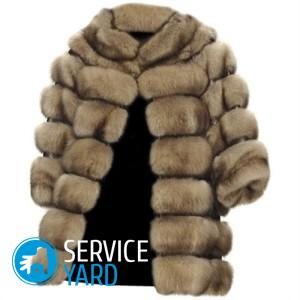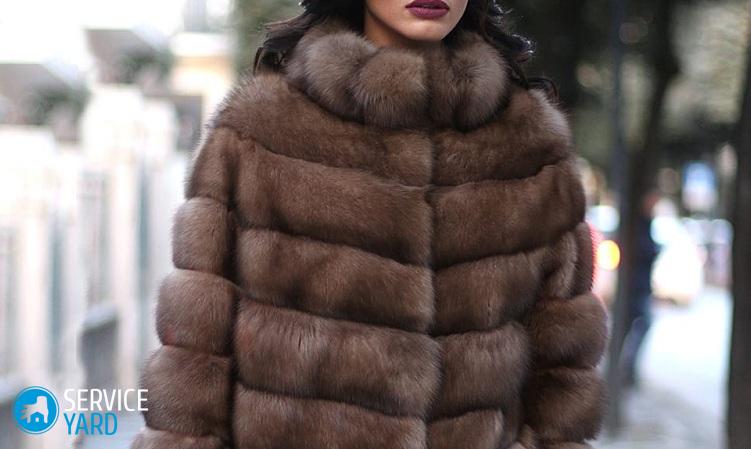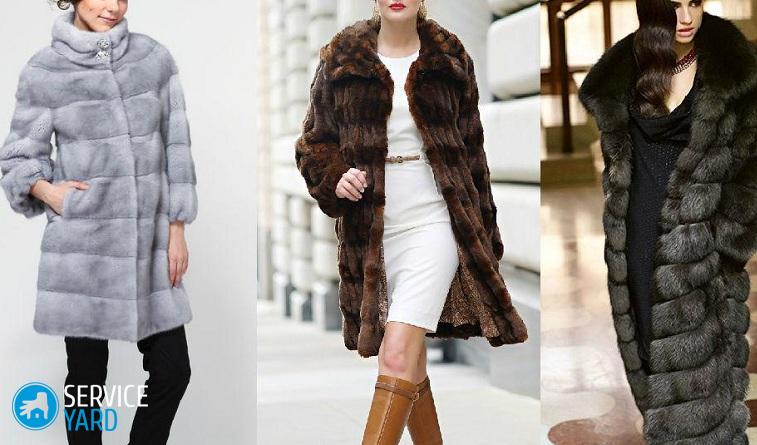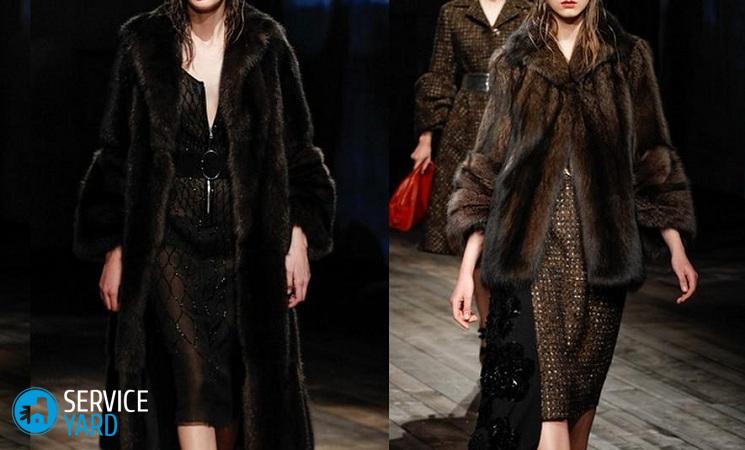How to alter a fur coat with your own hands - models

To part with an old fur coat is not so easy, especially if it is beautiful and expensive. Such things are usually worn for a very long time, but anyway, at one point, the style goes out of fashion, scuffs appear on the sleeves, and bald patches appear on the seams. What if the once elegant fur thing has lost its appearance, but they cannot offer anything acceptable in the nearest fur workshop? There is only one way out - to master the furrier craft. How to alter a fur coat with your own hands? Models can be very interesting. Now we will discuss them.
to contents ↑Getting ready for work
Regardless of what you will do from an old fur coat, for example, from a raccoon, nutria, fox or astrakhan, you will need some things, and it is better to prepare them in advance. Before you alter and reshape, enlarge or lengthen a fur coat from a muton with your own hands, as well as from any other fur, prepare:
- a pattern of what you will sew;
- furrier knife (with retractable blade);
- tweezers;
- high-quality cotton threads No. 40 or No. 45;
- needles for the skin.
As for the materials, you will have a part of them with a guarantee - the very fur coat to be remade. But one fur is not enough. You need:
- viscose lining fabric;
- if a design idea requires it - pieces of leather;
- accessories (buttons, buttons, etc.).
Where to get the pattern?
It is best to make basic patterns. Fur coats and dresses are sewn on them. The basic pattern can be modeled, which is exactly what you now need. Where to get it? You can do different things:
- order at the studio;
- find something suitable in magazines or on the Internet;
- build on your own;
- rip and circle the details of an old, but suitable in size product (best gown).
You need basic patterns:
- shelves;
- backs;
- sleeves.
The simplest options are to find in a magazine or circle the details of old clothes. In order to correctly build a pattern, you need a special allowance. Most often these are professional publications or old books on needlework - there are quite a lot of them on the Internet. You can also study contemporary literature.
Take measurements
Regardless of how you decide to get a pattern, you need to know your measurements. Without them, you simply can’t pick up and fit a pattern. In order to sew or suture something else from a lost coat, you need to know:
- chest girth;
- waist circumference
- hip girth;
- neck circumference;
- product length;
- sleeve length;
- seam length from armpit to waist;
- shoulder width;
- shoulder length.
to contents ↑Important! When constructing patterns, horizontal measurements are divided by 2.
Fur preparation
Before you alter a fur coat with your own hands, you need to look at what kind of material you have to deal with. Rate how good your fur is:
- Find out which pieces can be used and which ones are best removed.
- To determine the strength of suspicious places, moisten them with warm water and leave them alone for half an hour, and then try to carefully stretch the mezra. If she does not begin to tear and all the hairs remain in their places, the fur can be safely used.
- Select a style.
- Calculate how much fur you need, what other materials you can add.
- Spread a fur coat.
Unzip the fur coat
The first step is to undo the lining.No special equipment is needed for this - a simple tailor's ripper is enough.
Important! It is not very advisable to use a blade; you can damage the mezra.
Lay out the details of the fur coat, and on them are the details of the pattern. See if there is enough fur or have to combine.
How to cut?
When considering options for how to remake a fur coat, consider several features of this material. Such knowledge is useful when working with a muton, and with nutria, and with mink. New parts are cut in the middle, not in the fur. It is done like this:
- Put a piece of fur with the mazra up.
- Apply a pattern detail to it.
- Chip off the details - in this case, not tailor pins, but the most ordinary stationery buttons are more suitable.
- Cut the stock with allowances with a sharp furrier knife, barely touching so as not to cut the pile.
Important! Never press the fur against the table.
How to stitch?
Remaking old fur coats into fashionable ones with one's own hands is a pretty monotonous occupation and requires a lot of patience. Get ready to stitch manually. To work with fur, the following seams are used:
- "Goat":
- furrier (over the edge).
Important! Why is manual seam better than machine? Everything is very simple. The pile will have to be constantly refueled so that it does not remain on the wrong side. At the same time, the seam should be on the skin, and not on the pile - the fur hides your work. The thread should be tightened very carefully. The stitches should not be too tight or too loose. In the first case, you run the risk of tearing the mezra, in the second - the seam will not hold.
Seams, which have a large load, must be strengthened. For this, doubler serves. You can use special adhesive pads for leather and fur, they are also sometimes sold in sewing and fur stores. The seams will have to be carefully aligned. For this we need:
- foam sponge;
- oppression.
The seam is moistened with a sponge, after which something heavy is placed on it (for example, an iron, you just do not need to turn it on). It is necessary to wait until it dries completely, and only then proceed to the next stage. After the seam has dried, the fur should be combed along the seam - first against the pile, then in the direction of hair growth.
Threads and needles
If you want to alter a fur coat with your own hands - the master class begins with a choice of threads. For such work, cotton of medium thickness is always used. Synthetics simply cuts the mezdra.
Needles are better to buy special, for fur. But if those suddenly do not appear in the sewing store - you can buy ordinary ones that correspond to threads No. 40 or No. 45.
to contents ↑Let's talk about models
There are many ways to deal with an old fur coat. You can not alter anything at all, but simply shorten the hem or sleeves, as well as hem. These are the simplest options, so let's start with them.
Shorten the bodice
This method is suitable for products from any fur, but there is one condition - the fur coat must be detachable. She may be:
- on the yoke;
- cutting along the waistline;
- with a low waist, that is, a cut-off along the hips.
Important! This method is recommended if the horizontal seams do not coincide with the corresponding lines of your body.
In this way, you can very significantly change the style.
- Spread the seam with which the upper part is stitched to the lower.
- Set aside the desired length along the side seam of the bodice or skirt.
- Sweep the details.
- Try on what happened.
- Sew the top and bottom with a “goat” or furrier seam.
Important! From the remnants of the fur you can make jewelry or sew a clutch.
We repair a subboard
This part of the fur products is most often worn away. The bead rubs against clothing, resulting in receding hairline. Parts are best replaced, and at the same time put in new hardware, because the buttons and hooks also wear out over time.
Important! New picks can be made from faux fur, leather and even dense fabric, but the first two options are better.
Shorten the sleeves
The lower parts of the sleeves also “bald” quite often. There are two ways to deal with the problem:
- trim and hem if sleeves are long;
- sew on new cuffs.
It is better to hem with other material. There is no need to completely open the sleeve - it is enough to tear off the edge of the lining and insulation (if any), the hem and part of the seam adjacent to the cuff.
Bald spots, if they are at the very bottom, are best cut off:
- Measure the width of the sleeve (along with the allowances).
- Cut a strip 3-5 cm wide from leather, faux fur or dense fabric - its length is equal to the width of the sleeve.
- Align the long section of the strip with the bottom of the sleeve, with the sides facing each other.
- Sew a seam.
- Fold the strip to the wrong side, and pull the fibers that have fallen into the seam with a needle to the front side.
- Bend the strip to the wrong side by 0.5 cm and sew it with a “goat”, tucking under it the edge of the lining and insulation.
Hem a fur coat
Want to shorten your old fur coat? Make it easy. Have to rip a little - just a bend. By the way, do not forget to carefully look at how it is implemented - this will greatly facilitate your task:
- Open the lower hem (side seams can be left open).
- Set aside the fur coat at the side seams, do not forget about the width of the hem itself.
- Shorten the lining and insulation by the same amount.
- Soak the place that you will be hemming with a sponge on the side of the mezra, bend and put under the press.
- Insert the edge of the lining into the hem.
- Hem the coat with a goat seam.
- Comb the hairs on the front side so that they lie naturally.
We alter a fur coat
If there are a lot of damaged places and the product cannot be updated in simple ways, you will have to undo it and sew something new. There are places that wear out most intensively:
- collar;
- sleeve bottom;
- shoulder seams;
- in long fur coats - hem hem.
Damaged areas, of course, you will not need. The first thing to do is to remove them, and then to undo what is left.
Fur vest
The easiest way to remake an old fur coat, which has badly worn sleeves and a collar, is to sew a vest from it. Any fur is suitable for this. You will also need:
- lining fabric;
- two buttons.
If there is a pattern - very good, but in this case nothing can be done without it.
Important! Marking can be done directly on the mezdra (better to draw with a ballpoint pen). It is necessary to use as much as possible whole parts - shelves for the front, back - for the back.
How to alter a fur coat with your own hands, having on your hands a vest pattern:
- Place the pattern on the appropriate part of the fur coat and pin it.
- Circle the outline.
- Make allowances and circle again.
- Cut with a sharp knife (you can use scissors with short ends, but it will be long and inconvenient).
- Sweep parts at the shoulder and side seams.
- Try on, if necessary, correct, and then cut the lining according to the corrected pattern.
- Mark the clasp and sew on the buttons.
- Iron the lining allowances on the wrong side.
- Sew a lining (it is better to do it manually).
Important! The armholes and neckline can be trimmed with stripes of leather.
Bolero
This is a short vest, it can be sewn from a very worn coat. Since the shelf and backrest are short, they can be cut from any whole parts. The main thing is to make sure that on different fragments the direction of the pile is the same. Everything else is done the same way as when sewing a regular vest.
Combined fur coat
If there is a lot of fur, but the whole fur coat from it still does not work, you can make a combined one. Thus, you can alter the fur coat from nutria with your own hands, and from other types of fur, too.
Two ways are possible:
- with leather ribbons;
- with leather inserts at the waist or sleeves, as well as with leather patch parts.
In the first case, the same horizontal stripes of leather and fur are cut out. They are best done on a pattern. The strips are sewn together, and then the whole product is assembled. In the second method, parts or their fragments are made of leather.
to contents ↑Mouton and its possibilities
Mouton, who is also a tsigeyka, is considered to be almost eternal fur. So it’s quite possible that somewhere in the grandmother’s closet there is still a fur coat, bought half a century ago and long gone out of fashion. It's time to make something interesting out of her. At your disposal will be a dense and heavy fur, which is best used for its intended purpose, that is, to make a new coat from an old coat, modifying it with one of the methods already proposed.
This fur is not suitable for making jewelry. But you can sew from it:
- short fur coats;
- Jackets
- vests;
- plaids;
- carpets.
The procedure for making a plaid or carpet is pretty common:
- Spread the coat without touching the side seams.
- Remove bald patches.
- Assemble a new banner, picking up the parts along the contours - you can even make a template.
- Cut the missing parts from other fur or leather.
- Process the edges with an oblique inlay.
How to alter a mink coat with your own hands?
Parting with expensive fur is especially offensive. The mink coat can be updated while maintaining the maximum number of details. If there is a lot of fur, nothing prevents you from making a short fur coat or a fur coat-mix with inserts. But there are other options.
From this fur you can sew:
- a skirt, complementing it with a leather jacket with inserts from the same mink;
- a hood with a mantle or a short medieval cloak;
- plaid;
- footwear;
- mittens, hat and even a scarf;
- jewelry;
- bag.
to contents ↑Important! The mink is beautifully painted, so it may not be necessary to alter anything - the yellowed fur can be painted in a different color, and the fur coat will look like new.
Nutria
Nutria has a long and rather hard fur. It is warm and durable, and also has water repellent properties. Oddly enough, such a fur coat can not only be altered, but even bandaged. To do this, you need to spread the thing and dissolve it into strips 2-3 cm wide. Do this very carefully, trying not to cut the pile. All this is wound up in a ball, wool, cotton or acrylic thread is added, and then it is crocheted with a thick hook.
You can link:
- mantle;
- stole;
- plaid;
- cloak;
- vest or jacket.
Stock footage
In a word, there are a lot of options for creating new clothes or household items. But what should not be done in any case is to store spoiled fur products in the apartment. They not only clutter up the closet. Such things are very attractive to moths, so that if you do not understand the old fur coat in time, you risk parting with new fur or wool things. Having altered an ordinary mouton fur coat in stylish, according to our recommendations, you will be doomed to admiring glances! Post photos online so others can get inspired too!)
- How to choose a vacuum cleaner taking into account the characteristics of the house and coatings?
- What to look for when choosing a water delivery
- How to quickly create comfort at home - tips for housewives
- How to choose the perfect TV - useful tips
- What to look for when choosing blinds
- What should be running shoes?
- What useful things can you buy in a hardware store
- Iphone 11 pro max review
- Than iPhone is better than Android smartphones







